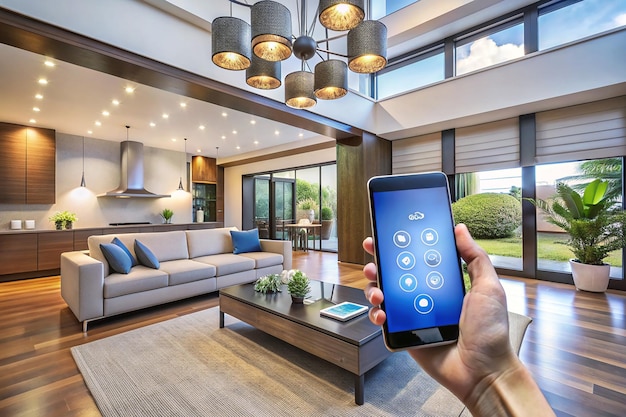Introduction to Home Automation

Welcome to the future of living with Wired Smart Solution, where we transform houses into smarter homes through innovative automation technology. Home automation, once a luxury, has become an essential part of modern living, offering unparalleled convenience, security, and energy efficiency. Home automation systems integrate various household functions lighting, temperature control, security, and entertainment into one seamless, intuitive system. This integration allows homeowners to manage their living environments with unprecedented ease and efficiency.
Table of Contents
ToggleKey Takeaways
- Simplicity and Control: Manage your home effortlessly through smart devices.
- Cost Savings: Reduce energy bills with efficient resource management.
- Security: Enhance the safety of your home with automated systems.
Overview of Home Automation
Home automation, or “smart home technology” represents the apex of digital convenience in residential living. This system involves automating the electronic and electrical systems of a home, allowing them to be controlled remotely or via local networks. From adjusting your home’s temperature to setting security alarms before bed, home automation offers a streamlined, intelligent approach to manage your living space.
The primary components of a typical home automation system include:
- Central Control System: Often a wall-mounted panel, smartphone app, or voice-activated device.
- Sensors: Used to detect changes in motion, temperature, light levels, or security breaches.
- Actuators: Mechanical mechanisms that control a device or system, such as motors, motorized valves, or light switches.
- Controllers: Devices that send and receive messages about the status of automated features, often via Wi-Fi or Bluetooth.
Harnessing Technology for a Better Home Life
The essence of home automation lies in its ability to integrate technology seamlessly into everyday activities to improve quality of life. Here’s how it brings unparalleled benefits to homeowners:
- Convenience at Your Fingertips: Imagine adjusting settings in your home while lying in bed or from miles away while on vacation. Home automation systems offer this convenience, ensuring that everything from your morning coffee to your security system is managed with minimal effort.
- Energy Efficiency and Cost Savings: Smart homes are not only about comfort but also about efficiency. Automated thermostats and smart light bulbs save energy by adjusting themselves based on real-time usage and conditions, leading to noticeable reductions in utility bills.
- Enhanced Security: With integrated security systems, including surveillance cameras and smart locks, homeowners can monitor their homes remotely, receiving alerts if the system detects unusual activity.
- Accessibility: For elderly or disabled individuals, home automation can provide increased independence. Automated voice commands and remote controls allow easy management of the home’s systems without physical interaction.
- Value Addition to Property: A smart home is not just a modern home but also an investment. The advancements in home automation can significantly increase the market value of a property, making it more attractive to prospective buyers who value technology.
In-depth Look at Home Automation Components
To fully understand how home automation works, it’s crucial to delve deeper into its components:
Central Control System:
This is the brain of the home automation setup. It could be a dedicated touch screen control panel or a software application on a smartphone. This system receives user inputs and sends commands to various devices around the house.
Sensors:
Sensors play a critical role in automation. Temperature sensors adjust the heating or AC; light sensors control the brightness of lights based on the time of day or room occupancy, and security sensors trigger alarms when detecting intrusions.
Actuators:
Actuators are the arms and legs of home automation. They perform the physical tasks. Whether it’s a smart thermostat adjusting the room temperature or automated blinds adjusting according to sunlight, actuators make the decisions of the central control system a reality.
Networking:
Effective communication between various components of a home automation system is facilitated through networking. This can be achieved via Wi-Fi, Zigbee, Z-Wave, or Bluetooth, ensuring that all components can communicate back to the central control hub without physical wiring.
Transforming Daily Living
With home automation, routine tasks are simplified, and management of the home environment becomes an activity of leisure rather than a chore. This technology not only enhances comfort and security but also adapts to the homeowner’s lifestyle to provide a truly customized living experience.
Integration with Renewable Energy:
Home automation systems can integrate seamlessly with renewable energy sources, such as solar panels. They can manage energy consumption more effectively by using surplus solar energy during peak sun hours and reducing reliance on the grid, which is not only eco-friendly but also economical.
Future of Home Automation:
As technology advances, the future of home automation holds even greater potential. Integration with AI and machine learning can lead to systems that anticipate the homeowner’s needs and adjust the environment accordingly, providing a new level of personalized living.
Benefits of Home Automation
- Enhanced Convenience: Automate daily tasks like adjusting thermostats or turning off lights with a simple voice command or a tap on your smartphone.
- Increased Energy Efficiency: Intelligent systems optimize energy usage, significantly reducing costs by managing resources like electricity and heating more effectively.
- Improved Home Security: With automated alarms and surveillance, you are always in the know about your home’s security, no matter where you are.
- Comfort and Customization: Tailor your living environment to your preferences, from ambient temperature to mood lighting, all controllable with smart devices.
How Does Home Automation Work?
At its core, home automation systems function through a network of interconnected devices that communicate over home Wi-Fi. Advanced sensors and programmable controls allow these devices to perform tasks automatically based on user preferences or sensor detections. Learn more about the technology behind home automation here.
Setting Up Your Smart Home with Wired Smart Solution
Setting up home automation might seem daunting, but with Wired Smart Solution, it’s a breeze. We provide comprehensive installation and integration of smart devices, ensuring your home is connected and ready to go.
Conclusion
At Wired Smart Solution, we are committed to making your home as smart and efficient as possible. Ready to upgrade your living experience? Contact us today and let us help you harness the power of home automation!
FAQs
To begin, you need a reliable Wi-Fi network, a smart device, and your choice of home automation products.
Yes, modern home automation systems are equipped with advanced security protocols to protect your data and access to your home.
Absolutely! Most systems come with apps that allow you to manage your devices from anywhere in the world.
Starting with smart speakers, thermostats, or security cameras is usually the best approach.
By optimizing the use of lighting, heating, and AC, smart systems reduce unnecessary energy consumption.
Useful Links
Sitemap
Subscribe
Stay always in touch! Subscribe to our newsletter.

